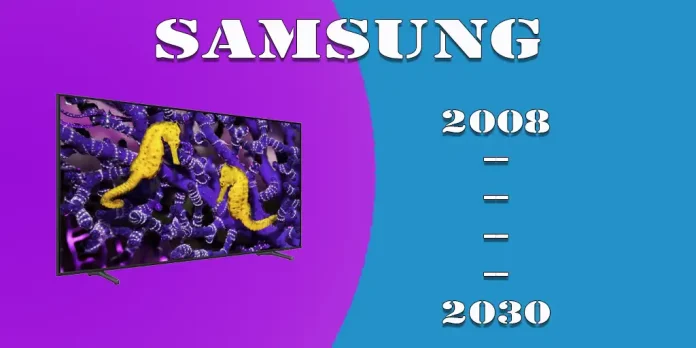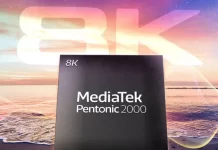Our team diligently updates information on the Samsung TV model number annually so that our readers can access the latest data. If you are wondering how to understand the model number of your Samsung TV, read the article “Samsung TV Model Number Decoding” which explains the model number structure in detail. Whether you’re trying to determine the year of your Samsung TV or choosing a new TV, our resources can guide you. You can refer to the table that shows the TV lines and TV model numbers by year; you can see the table and detailed explanation below.
List of Samsung TVs by year from 2008 to 2024
As of 2024, Samsung offers seven TV lines, each with significant technical differences that justify their distinct classifications. For example, the Crystal UHD TV and the OLED 9 Series differ greatly in picture quality, making this division both reasonable and essential.
| Year | Plazma & LED | QLED 4K | NEO QLED | OLED | QLED 8K & Neo QLED 8K | Life Style | Projector |
|---|---|---|---|---|---|---|---|
| 2024 | DU**** DUX1E | QE1D Q9*D Q8*D Q7*D Q6*D | QNX1D QN9*D QN8*D | S8*D S9*D | QN9**D QN8**D | LS01D LS03D | LPU9D LPU7D |
| 2023 | CU**** | Q9*C Q8*C Q7*C Q6*c | QN9*B QN8*B | S8*C S9*C | QN9**C QN8**C QN7**C | LS03C | |
| 2022 | BU**** | Q9*B Q8*B Q7*B Q6*B | QN9*C QN8*C | S9*B | QN9**B QN8**B QN7**B | LS03B LS05B | |
| 2021 | AU**** | Q9*A Q8*A Q7*A Q6*A Q5*A | QN9*A QN8*A | QN9**A QN8**A QN7**A | LST9T LS03A | ||
| 2020 | T**** TU**** | Q9*T Q8*T Q7*T Q6*T | Q9**T Q8**T Q7**T | LST7T LS05T LS03T LS01T | LSP7T LSP9T | ||
| 2019 | R**** RU**** | Q9*R Q8*R Q7*R Q6*R | Q9**RB Q9**R | LS03R LS01R | |||
| 2018 | N**** NU**** | Q9FN Q8FN Q7FN Q7FCN Q6FN | Q900RA | LS03N | |||
| 2017 | M**** MU**** | Q9F Q8F/C Q7F/C Q6F | LS003 | ||||
| 2016 | K**** KU**** KS**** | ||||||
| 2015 | J**** JU**** JS**** | ||||||
| 2014 | H**** HU**** | S9 | |||||
| 2013 | F**** FH**** | ||||||
| 2012 | ES**** EH**** E**** | ||||||
| 2011 | D**** DH**** | ||||||
| 2010 | C**** CH**** | ||||||
| 2009 | B**** BH**** | ||||||
| 2008 | A**** AH*** |
Overview of Samsung TV model numbers by year
Plasma and LED TVs: The model numbers of Samsung’s LED TVs have changed several times
From 2008 to 2013, Samsung produced plasma TVs, for example, models PS32A5000 (2008 plasma TV) and UN32E7000 (2012 LED TV).
In 2014, Samsung released the first LED TVs with 4K (UHD) resolution, denoted by an additional letter in the model number, such as UN32HU7000. In 2015, “super” models with improved screens appeared, for example, model number UN40KS7000, available from 2015 through 2016.
With the advent of QLED in 2017, LED TV model numbers took on a final format that has remained to this day. An example is the 2024 UN75DU8000 model.
QLED 4K: Introduced in 2017, this lineup includes “super” TVs with screens based on quantum dots that allow for a broader range of hues using dithering technology. The eight—and nine-series TVs typically support 120Hz and feature panels with true 10-bit color depth. Sample model numbers are QN75Q9FN (2017-2018) and QN75Q85D (starting in 2019).
QLED 8K and Neo QLED 8K: Samsung released its first 8K resolution TV in 2018, such as model number QN75QN900D (2024). This lineup represents the pinnacle of quality QLED TVs, offering more pixels and 120Hz.
Neo QLED 4K: Neo QLED TVs, introduced in 2021, feature QLED screens with 10-bit color depth capable of displaying 1 billion shades at 120 Hz. The letter N (Neo) is appended to the model number, example model number QN75QN90D.
OLED: After a first attempt in 2014, Samsung began mass production of OLED TVs in 2022. These TVs, such as the QN65S95D, use displays made with Samsung’s QD-OLED technology or LG’s WRGB four-color OLED panels.
Life Style: Introduced in 2017, this lineup includes TVs with unique features such as The Sero with swivel, TVs that resemble paintings, and models designed for outdoor use. Example model number QN43LS03D (2024).
Projector: Samsung’s laser TVs, introduced in 2020, project an image onto a specialized screen. An example model number is SP-LPU9D.
This review did not include Micro LED TVs, which, despite the new technology, have been discontinued due to their high cost and lack of sales.
In addition, some TVs do not have the usual model number structure, such as the QNX1D. These TVs are assembled from components originally designed for earlier models but have received an operating system upgrade. This happens when Samsung’s production plans change, leaving extra components behind, which leads to the creation of “intermediate” models built on old hardware but with updated software; such TVs get the X index and sometimes appear on sale.






what about 2007
I cannot find the year of my Samsung tv. Everything I put in doesn’t work.
What is the model of your TV?